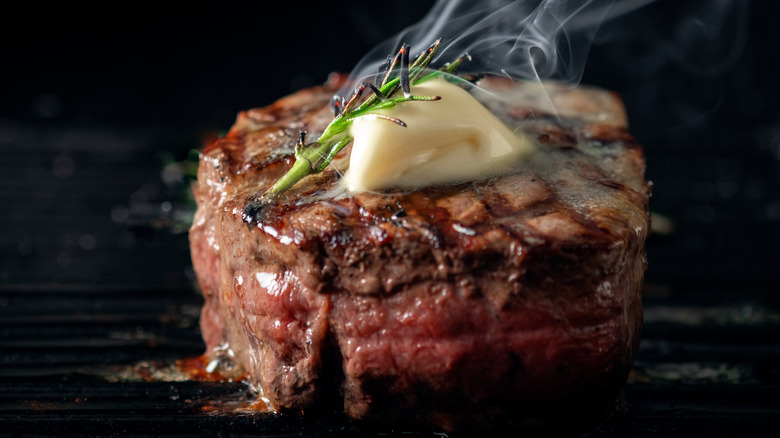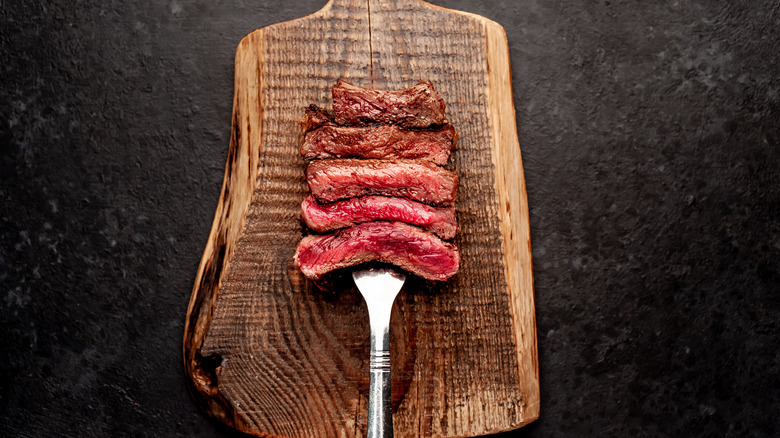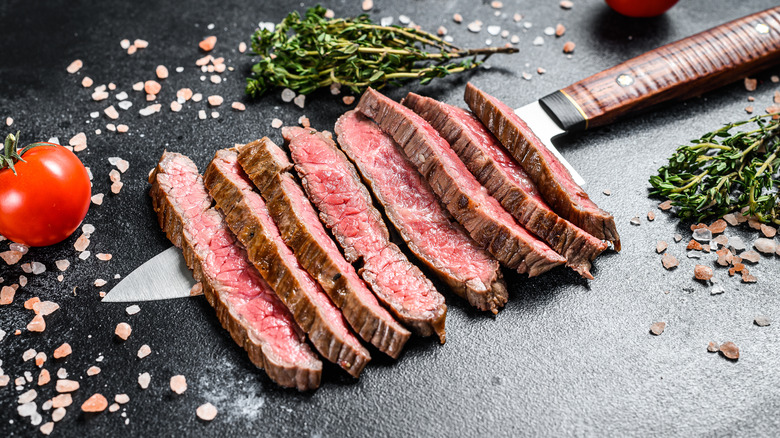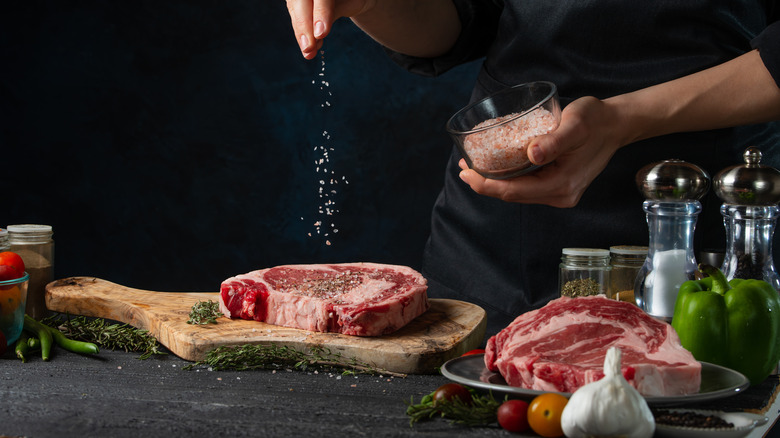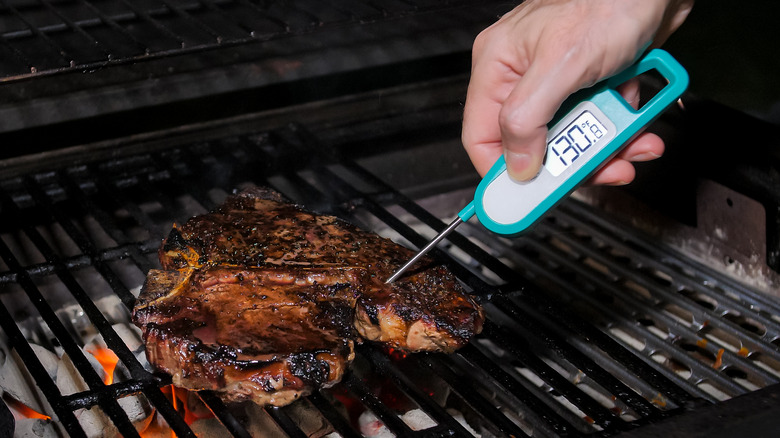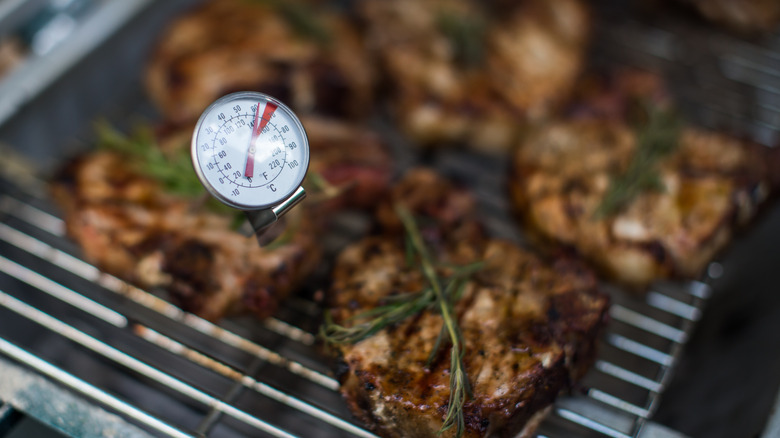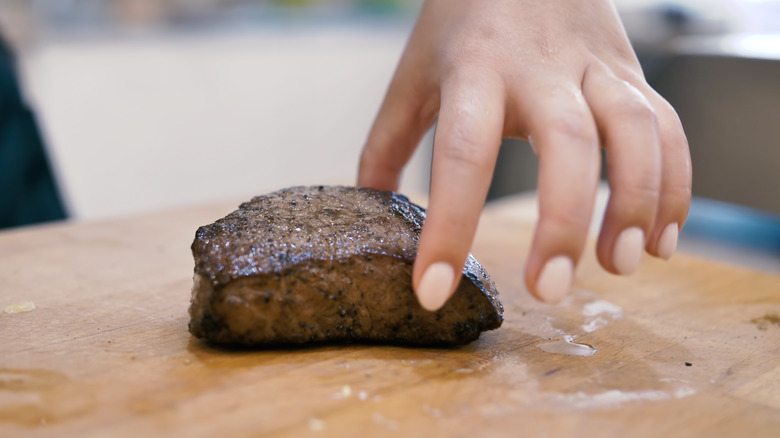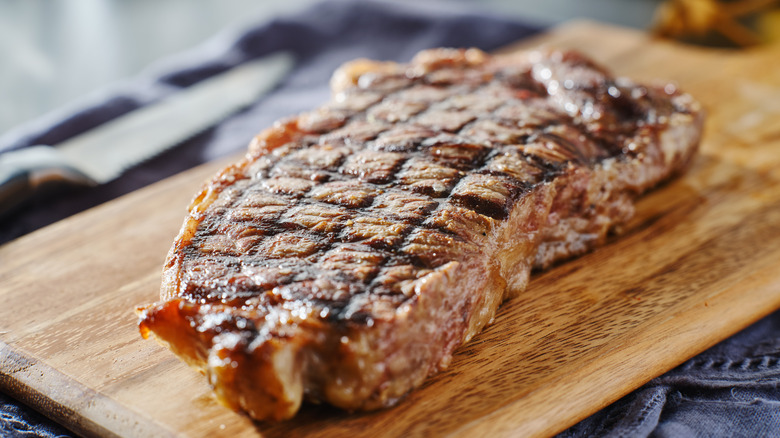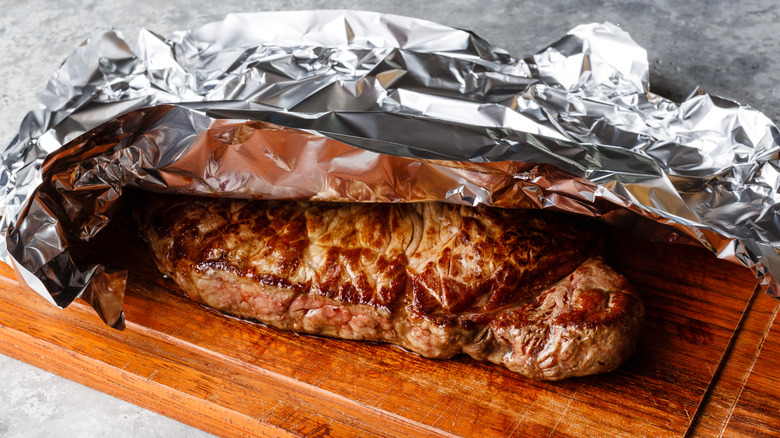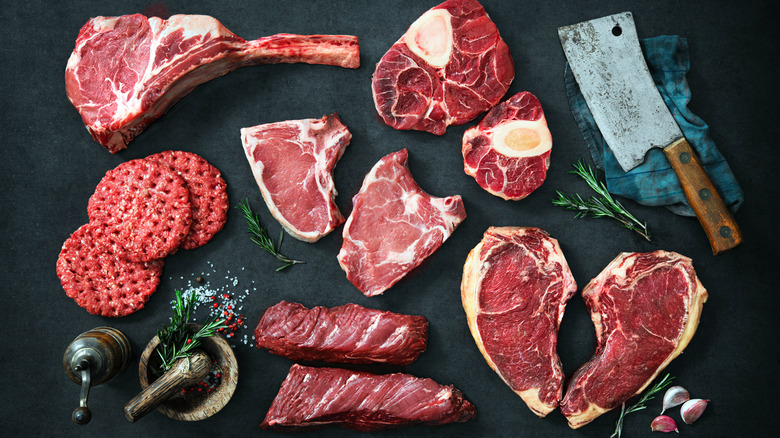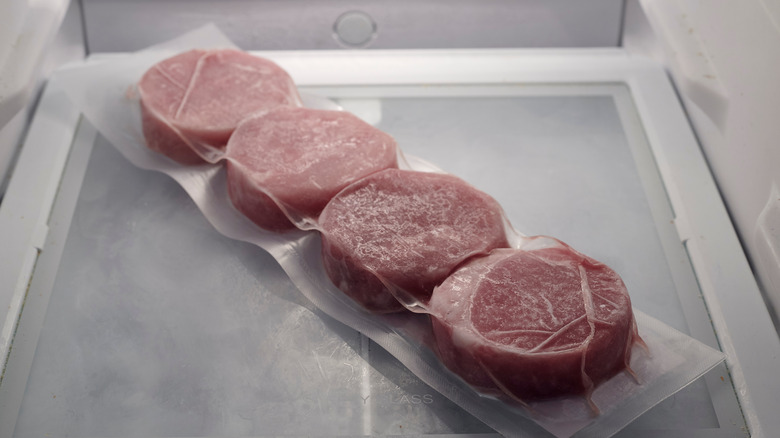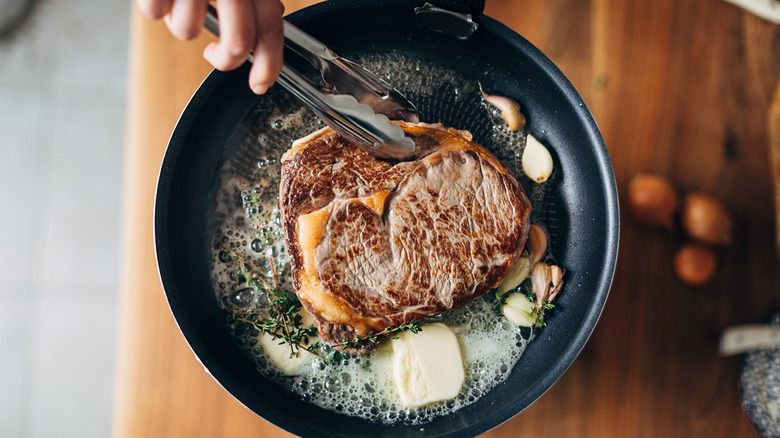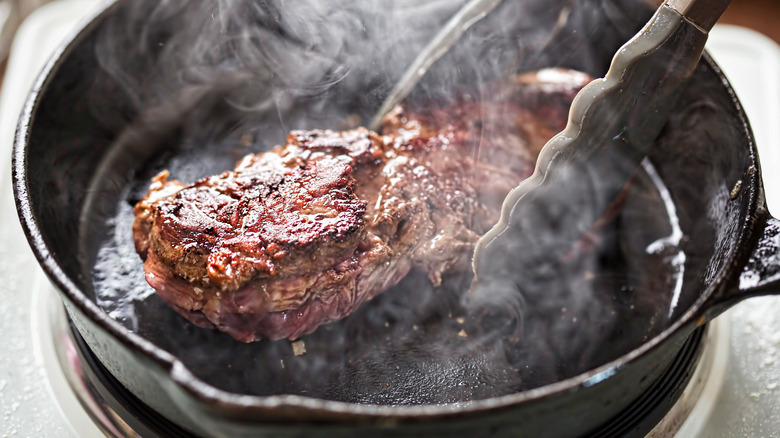Everything You Need To Know About Steak Doneness And Temperature
There's nothing like the perfect steak. A dark char on the outside, just your preferred doneness on the inside, filled with flavor and ultra-juicy ... but cooking the perfect steak is no easy task, even for accomplished chefs. How many times have you gone to a restaurant, ordered the steak, and then been disappointed to receive a meal that was undercooked, overcooked, dry, tough, or bleeding down the center? Nailing the perfect steak requires fine attention to detail and the ability to balance precisely in that small zone between too-rare and tough-as-leather.
However, you can make the steak-cooking process a little easier on yourself by more thoroughly understanding steak doneness and how temperature impacts your overall steak experience — thereby making it more likely that you truly can cook the perfect steak at home. To help you out, here's our quick guide to everything you need to know about steak doneness and temperature.
How to define rare, medium rare, medium, medium well, and well
First up, whether you're cooking for yourself or others, it's important to understand what exactly "rare," "medium rare," "medium," "medium well," and "well" mean in terms of doneness. You probably use these words all the time if you frequently order beef when dining out, but do you actually know their definitions beyond just, "oh, a medium-well burger should have only a little pink in the middle?"
The Daily Meal explains that, while some may profess to be able to determine a steak's doneness by feel or sight, there's only one true way to ensure that your medium steak is actually medium: temperature. An extra-rare or "bleu" steak will reach a maximum internal temperature of 115 degrees Fahrenheit. A rare steak will measure 120 to 125 degrees Fahrenheit. Medium-rare is between 130 and 135 degrees, while medium is 140 to 145. A medium-well steak will measure 150 to 155 degrees, and lastly, well-done is 160 degrees Fahrenheit or hotter.
The USDA doesn't approve of rare steak
While you may prefer your steak to resemble something closer to a raw cow than beef jerky, you may find the U.S. Department of Agriculture (USDA) disagrees with your tastes.
The USDA announced new recommended internal cooking temperatures in 2020 and the updated temperatures rule out anything below medium doneness as unsafe to eat. For whole cuts of beef (as well as veal and lamb), the USDA reports the safe internal temperature for a cooked item is 145 degrees Fahrenheit or higher. Anything less than that is deemed risky. Additionally, the organization recommends that all of these cooked cuts also undergo a three-minute resting period, during which the internal temperature will rise further, killing harmful bacteria. It's worth noting that this recommendation only applies to whole cuts of steak. For ground beef, like burgers, the USDA recommends cooking the beef to an internal temperature of at least 160 degrees Fahrenheit, or well done.
Why rare steak is risky
But what's the big deal? Is extra-rare, rare, and medium-rare steak really that risky? While some may think steak doesn't put you at risk for food poisoning as long as it's seared on the outside, that's not necessarily the case. A previous Mashed article went into the fine details of raw meat safety, but, essentially, raw steak's connection to food-borne illness outbreaks can all be traced back to the use of antibiotics in beef cattle.
Increased use of antibiotics makes beef tough, so some slaughterhouses tenderize beef via a method that drives metal blades deep into the individual cuts. This pushes bacteria from the exterior of the cut of beef to the interior, where the bacteria then waits around for some poor diner to order their steak raw. Sure, the searing process may kill off all the bacteria on the outside of that steak, but it doesn't do a thing to the bacteria lurking inside.
Proper thermometer usage
Getting your steak to the correct temperature (for taste, safety, or otherwise) is meaningless if you're not using your thermometer correctly. How you use your thermometer matters when it comes to determining the true, correct temperature of your steak.
For the most accurate reading, Epicurious recommends inserting your thermometer into your steak in the thickest portion of the cut. Watch out for any fat or bone, as touching either can impact your reading. You'll want to push the thermometer probe into your steak at least half an inch (though if you have a particularly fancy thermometer, you may be able to get away with less). If the steak itself is thicker than an inch, you'll want to push that thermometer all the way until you're fairly certain you're in the center of the meat.
If you end up with multiple readings during a single measurement, go with the lowest reading to be on the safe side.
What kind of thermometer to use
It's not only how you use your thermometer that matters, though. You also want to choose the right thermometer for the job. Epicurious notes that there are two different types of thermometers available to home cooks: digital thermometers and old-fashioned probe thermometers. The latter is going to be the most inexpensive, but also the least accurate. They also can take a while to work, meaning you're spending precious seconds with your steak on the stove or grill as you wait for a reading. A digital thermometer, on the other hand, can give you an instant reading; you can even find digital thermometers that remain in the meat via a stand-alone probe, sending measurements to another device as your meat cooks.
For the most accurate readings, then, go with a digital thermometer. Whether or not you go with a probe variant or an instant-read thermometer is up to your personal preferences.
What to do if you don't have a thermometer
Don't have a thermometer? Don't have time to go out and buy one? If you're cooking steaks, like, now and want to attempt the perfect doneness, there is one tried and true method that's at least reasonably reliable: the finger test. Simply poke the steak with your finger to test the firmness. The firmer the meat, the more done it is. You can fairly accurately gauge the doneness level of a steak using this method.
So what does each doneness level feel like? Simply Recipes broke it down. To get an idea of the various doneness levels, you'll want to compare the feel of a steak to the firmness of your opposite hand in various positions. Lay your hand palm-up, relaxed, fingers outstretched, and poke the meaty bit of the base of your thumb, right underneath your palm. That's what a raw steak should feel like. Press your thumb and pinky together and give that same spot a poke. That's what a well-done steak feels like. Continue this process, only press your thumb and ring finger together to get the firmness of a medium steak, then your thumb and middle finger for medium-rare, and lastly your thumb and index finger for rare.
Once you have an idea of how your steak should feel, you can poke it every so often during the cooking process until you've reached your desired doneness.
Carryover cooking
Cooking the perfect steak isn't just about bringing your steak to the perfect temperature for the doneness you want, verifying the internal temperature with your trusty thermometer, and then pulling it off your heat source and serving. Carryover cooking (or the continued rise of an item's internal temperature once it leaves its heat source) will keep on cooking your steak even after you've turned off the grill, meaning you need to strategize accordingly.
According to Cook's Illustrated, you should approach cooking any piece of meat with carryover cooking in mind. When you take a temperature reading, you should be gauging not if the steak is done right at that second in time, but whether or not it's reached a high enough temperature that the carryover cooking will continue raising the temperature until the steak is your desired doneness.
So how do you account for carryover cooking? It depends on the size of the steak, as well as the temperature of your heat source. For steak cooked at a moderate heat, Cook's Illustrated recommends taking your steak off its heat source at 115 to 120 degrees Fahrenheit for a rare steak, 120 to 125 degrees Fahrenheit for medium-rare, 130 to 135 degrees Fahrenheit for medium, and 150 to 155 degrees Fahrenheit for well-done.
Letting your steak rest
The carryover cooking process works best when you refrain from cutting into your steak (or other cut of meat) for at least a few minutes after you've removed it from your heat source. But giving your steak some resting time isn't just an important part of reaching your desired doneness. That rest time also contributes to your steak's overall moisture levels. As your steak cooks, the heat pushes moisture to the center of the steak, where it collects; as the steak cools, that moisture is re-distributed, making for an evenly juicy steak.
The Spruce Eats recommends allowing your steak to rest for either approximately however long you cooked it, or five minutes for every inch of thickness. Others recommend allowing your steak to rest 10 minutes for every pound. Whichever method you follow, though, it's likely that you'll end up allowing your steak to rest for about five to seven minutes. If you're worried about the steak losing too much heat during that time frame, you can always cover it with some loose aluminum foil.
Choosing the right kind of steak for your cooking method and time
Actually getting to the desired internal temperature you want without ruining your cut of meat will depend on your cooking method. Some steaks just won't hold up to low, slow heat without going all dry and grossly gray in the middle, while some steaks just can't be cooked fast and hot if you want any chance at all of getting that internal temperature to somewhere in the USDA's "safe" range. Because of this, you'll want to be sure you're cooking your steak via the correct method based on its cut and size.
AllRecipes advises cooking ribeyes, skirt, flank, and marinated hanger steaks quickly, over high heat on the grill or in a skillet. New York strip steaks can be also be cooked over high heat on the grill or via the sear-to-broiler method. Filet mignons are ideal for the stovetop-to-oven method. T-bone and porterhouse steaks should be cooked on the grill, with the strip of the steak over the higher heat and the tenderloin portion of the steak over lower heat; tri-tip steaks are likewise suitable to cook on the grill.
Pre-cooking steak prep
Before you can get to any of the above, you need to make sure to follow one very important tip: Let your refrigerated (or frozen, if that's the case) steak come fully to room temperature before you even attempt to cook it. This is very important for your steak's internal temperature and doneness, as well as its end texture.
Steak School by Stanbroke (an Australian-based beef producer) asked a handful of chefs about this part of the steak-cooking process and they all agree: Letting your cold steak come to room temperature is vital for a perfectly-cooked finish. It will ensure the exterior doesn't cook too quickly before the interior even has a chance to heat up. It also will ensure that the steak is more evenly done and more tender, as exposing the cold meat fibers to too drastic of a temperature change can cause them to tense up, resulting in tough meat. There are two exceptions to this rule and that's if (a) you've dry-brined the steak or (b) you're cooking the steak in a low-temperature oven; in either case, there's no need to bring the steak to room temperature. If you do need to let your steak come to room temperature, the consensus is to let it sit for about an hour.
Moving the steak around when cooking
If you're grilling or pan-searing your steak, you'll want to move it around the cooking surface, which will help you achieve a more even doneness. While the old adages always tell you to not move your food around too much while cooking, there's actually proof that moving your steak around will not only allow you to brown your steak just as much as not-moving, but you'll also benefit from a few advantages, including a faster cooking process and more even doneness.
Serious Eats put these claims to the test and found that cooking a steak with multiple flips until it reached an internal temperature of 130 degrees Fahrenheit resulted in even doneness more like what you'd find with sous vide cooking, rather than grilling. The publication chalked this up to the flipping allowing each side of the steak to cool down for a split second, letting heat buildup dissipate, preventing spotty overcooking.
How to save undercooked steak
Let's say you've followed all the tips above and think you've mastered the perfect steak. Then, you get that steak to the table, after letting it rest for the appropriate amount of time, you cut into it ... and it's far too undercooked. The good news is, even if you've bungled your cooking process, you can still save an undercooked steak.
According to Reviewed, if your steak is thoroughly done on the outside, but still raw on the inside, you can quickly heat the inside of the steak without overcooking the outside by popping it into your oven. You'll want to heat the oven to 500 degrees Fahrenheit, with your cast iron pan inside, then oil the pan, place the steak inside, and allow it to cook in the oven for two to four minutes per side. Once your thermometer tells you the steak is at 140 degrees Fahrenheit, remove it from the oven and let it rest on a plate for 10 minutes.
If your steak is too raw both inside and out, you can simply heat your oiled cast iron pan on the stovetop and then cook the steak two to four minutes per side until it reaches your desired doneness, again letting it rest for 10 minutes. Whatever you do, Reviewed says, don't cut your steak into smaller pieces or use the microwave when trying to remedy your undercooked hunk of meat. You'll only end up with a dry, lackluster meal.
